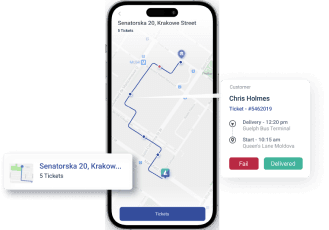Did you know that—real-time Location Systems (RTLS) is a powerful technology that helps track and manage assets, people, and equipment within specific areas? However, many people are still unaware of its potential. Often confused with GPS, RTLS works indoors, which offers pinpoint accuracy where GPS typically fails, such as inside buildings or warehouses.
This misunderstanding holds businesses back. It prevents them from realizing RTLS's full potential. They miss out on improving efficiency and monitoring.
So, let's dive deeper into what RTLS offers and how it differs from other tracking technologies. Once you understand its unique features, you can decide if it’s the right solution for your business.
What is RTLS?
Real-Time Location Systems offers a way to keep track of things or people within a set space. You get live updates on the exact location of tagged items.
So - why is RTLS useful?
It simply offers more control and visibility over your operations.
You should know that RTLS is different from traditional tracking systems. It provides real-time data instead of past information. You can use it in healthcare, warehouses, or manufacturing facilities.
It relies on technologies like RFID, Wi-Fi, or Bluetooth. Each technology has a unique way to pinpoint the location.
How Does RTLS Work?
RTLS works by attaching small tags to the items or people you want to track. These tags send signals to a network of receivers placed throughout the area. The receivers pick up these signals and pinpoint the location of each tag. The system then collects this data and displays the exact position on a map or dashboard for you to see.
You can choose different technologies to use with RTLS. Some systems use RFID, while others rely on Wi-Fi or Bluetooth. Each technology has its strengths. For example, RFID can track items passing through entry points. Wi-Fi can cover a larger area inside buildings. This setup allows you to monitor movement in real time. All while giving you complete visibility and control.
It is worth noting that the data gathered by RTLS can also be integrated into your business systems. Why? Just to help streamline operations and make quick decisions. After all, RTLS is all about reducing your search time, preventing loss, and improving efficiency.
Is RTLS The Same as GPS?
No. RTLS is not the same as GPS. GPS tracks locations using satellites, which makes it ideal for outdoor navigation and global tracking. In contrast, RTLS is used for tracking within a defined space, such as a building or facility.
GPS can lose accuracy indoors due to walls and obstructions. However, RTLS uses technologies like RFID, Wi-Fi, or Bluetooth to provide precise location data inside.
You should know that GPS works well for applications like vehicle navigation or outdoor asset tracking. Whereas RTLS excels in environments like warehouses, hospitals, or offices where you need detailed, real-time visibility.
So, while both GPS and RTLS track locations, they serve different purposes and work best in different environments.
What Are The Key Benefits of RTLS?
- Real-time asset and personnel tracking
- Enhanced operational efficiency
- Reduced search and wait times
- Improved safety and security
- Better inventory management
- Faster decision-making with live data
- Increased visibility and control
What Are The Current Challenges and Limitations of RTLS?
If you want RTLS to be effective, you must address several challenges.
Signal interference is a primary concern. For instance, physical obstacles such as walls, metal structures, and moving personnel can disrupt RTLS signals. What’s the consequence? Inaccurate location data or complete signal loss, especially in complex indoor environments (RFID Journal, 2023).
High deployment and maintenance costs also pose significant barriers. It requires substantial investment to set up RTLs if we consider the costs associated with hardware, software, and ongoing maintenance (Zebra Technologies, 2023). Its regular calibration and system upgrades increase overall expenses and operational complexity.
Compatibility and integration issues present another major challenge. RTLS technologies vary widely, which include RFID, Wi-Fi, Bluetooth, and Ultra-Wideband (UWB). It can be complex and time-consuming to integrate these different systems with your existing IT infrastructure (IEEE Xplore, 2023). The importance of seamless interoperability cannot be overstated. It supports smooth implementation. This approach helps avoid connectivity issues. It also prevents synchronization problems.
Battery life limitations affect the performance of RTLS, particularly for active tags that require continuous power to broadcast signals. Moreover, active tags need regular battery replacements or recharging, which increases maintenance efforts and operational costs (Atlas RFID Store, 2023). Passive tags have longer lifespans. However, they offer less frequent updates. They also have lower accuracy. So—this limits their effectiveness in certain applications.
Privacy concerns arise when RTLS tracks personnel. Employees may see RTLS as intrusive. This perception leads to resistance. It can also create potential legal issues. Its issues relate to data privacy and surveillance. You need to implement strong data security measures. You should also obtain consent. But, these steps address concerns. They ensure the ethical use of RTLS technology.
Securing buy-in from employees and managers is essential for successful RTLS adoption. Resistance often stems from fears of job displacement or unfamiliarity with the technology (Ubisense, 2024). Provide comprehensive training for everyone involved. Make sure you communicate the benefits. These actions help overcome obstacles. They also foster a supportive environment for RTLS implementation.
The need for a large number of sensors poses logistical and financial challenges. Accurate tracking requires extensive sensor networks, which can be time-consuming and costly to install (Ubisense, 2024). It adds to the management overhead to maintain and calibrate these sensors over time. It makes scalability a concern for growing organizations.
Lastly, accuracy and reliability issues can impact the overall effectiveness of RTLS. Environmental factors can mess with signal strength. The specific technology you use can cause multipath interference, too. This leads to inconsistent location data. You can maintain high accuracy with careful planning. Regular system checks also ensure reliable performance.
What Does The Future of RTLS Look Like?
The future of real-time location system technology is bright. It is estimated that the RTLS market will reach USD 16.2 billion by 2028, which growing at a CAGR of 25.5%.
Real-Time Location Systems (RTLS) are set to expand their market significance and application in the future throughout numerous industries.
Conclusion
Real-Time Location Systems offer significant benefits for various industries. Organizations can enhance efficiency and management through effective implementation. The challenges in deploying RTLS need attention, but they should not discourage exploration.
It opens the door for improved asset and personnel tracking when these challenges are addressed. As technology advances, RTLS will continue to shape the future of tracking solutions. RTLS will drive innovation and improve operational outcomes for companies that adopt it.

Aiden mitchell
As a GPS Tech geek, I find Lumyri's transformative impact on GPS technology on businesses and their customers. Real-time tracking information empowers businesses to provide accurate delivery estimates, allowing customers to plan their schedules with precision.




